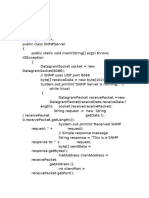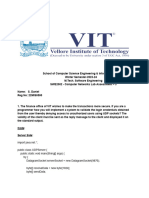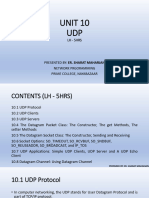0 ratings0% found this document useful (0 votes)
133 viewsMulticast Program
This document contains code for a multicast server and client program in Java. The server program sends 5 messages to a multicast group address and port over 5 seconds. The client program joins the multicast group to receive the messages sent by the server and prints them out.
Uploaded by
Balayogi GCopyright
© © All Rights Reserved
Available Formats
Download as PDF, TXT or read online on Scribd
0 ratings0% found this document useful (0 votes)
133 viewsMulticast Program
This document contains code for a multicast server and client program in Java. The server program sends 5 messages to a multicast group address and port over 5 seconds. The client program joins the multicast group to receive the messages sent by the server and prints them out.
Uploaded by
Balayogi GCopyright
© © All Rights Reserved
Available Formats
Download as PDF, TXT or read online on Scribd
You are on page 1/ 3
MULTICAST PROGRAM
SERVER:
import java.io.IOException;
import java.net.DatagramPacket;
import java.net.DatagramSocket;
import java.net.InetAddress;
import java.net.UnknownHostException;
public class MulticastSocketServer {
final static String INET_ADDR = "224.0.0.3";
final static int PORT = 8888;
public static void main(String[] args) throws UnknownHostException, InterruptedException {
// Get the address that we are going to connect to.
InetAddress addr = InetAddress.getByName(INET_ADDR);
// Open a new DatagramSocket, which will be used to send the data.
try (DatagramSocket serverSocket = new DatagramSocket()) {
for (int i = 0; i < 5; i++) {
String msg = "Sent message no " + i;
// Create a packet that will contain the data
// (in the form of bytes) and send it.
DatagramPacket msgPacket = new DatagramPacket(msg.getBytes(),
msg.getBytes().length, addr, PORT);
serverSocket.send(msgPacket);
System.out.println("Server sent packet with msg: " + msg);
Thread.sleep(500);
}
} catch (IOException ex) {
ex.printStackTrace();
}
}
}
CLIENT:
import java.io.IOException;
import java.net.DatagramPacket;
import java.net.InetAddress;
import java.net.MulticastSocket;
import java.net.UnknownHostException;
public class MulticastSocketClient {
final static String INET_ADDR = "224.0.0.3";
final static int PORT = 8888;
public static void main(String[] args) throws UnknownHostException {
// Get the address that we are going to connect to.
InetAddress address = InetAddress.getByName(INET_ADDR);
// Create a buffer of bytes, which will be used to store
// the incoming bytes containing the information from the server.
// Since the message is small here, 256 bytes should be enough.
byte[] buf = new byte[256];
// Create a new Multicast socket (that will allow other sockets/programs
// to join it as well.
try (MulticastSocket clientSocket = new MulticastSocket(PORT)){
//Joint the Multicast group.
clientSocket.joinGroup(address);
while (true) {
// Receive the information and print it.
DatagramPacket msgPacket = new DatagramPacket(buf, buf.length);
clientSocket.receive(msgPacket);
String msg = new String(buf, 0, buf.length);
System.out.println("Socket 1 received msg: " + msg);
}
} catch (IOException ex) {
ex.printStackTrace();
}
}
}
OUTPUT:
You might also like
- 61FIT3NPR - W09 Tut Multicast Socket NewNo ratings yet61FIT3NPR - W09 Tut Multicast Socket New5 pages
- Ashwin Pawar 23 Practical: 17: Name: Roll No.No ratings yetAshwin Pawar 23 Practical: 17: Name: Roll No.9 pages
- Advance Java Programming Assignment - 1No ratings yetAdvance Java Programming Assignment - 120 pages
- Experiment No. 7: Introduction of Multicast Socket Programming in Java ApplicationNo ratings yetExperiment No. 7: Introduction of Multicast Socket Programming in Java Application8 pages
- I) Create Datagram Socket at Port 9876: Jawapan Ke4No ratings yetI) Create Datagram Socket at Port 9876: Jawapan Ke42 pages
- Write A Program On Datagram Socket For Client/Server To Display The Messages On Client Side, Typed at The Server Side. Udpserver - JavaNo ratings yetWrite A Program On Datagram Socket For Client/Server To Display The Messages On Client Side, Typed at The Server Side. Udpserver - Java3 pages
- Datagram Sockets: Internet Programming with Java Course 1.5 UDP и Multicast сокетиNo ratings yetDatagram Sockets: Internet Programming with Java Course 1.5 UDP и Multicast сокети9 pages
- Name: G Ram Prasad Reddy Register Number: 15mis0384 Course Code: Swe2002 Course Name: Computer Networks LAB SLOT: L37+38No ratings yetName: G Ram Prasad Reddy Register Number: 15mis0384 Course Code: Swe2002 Course Name: Computer Networks LAB SLOT: L37+3817 pages
- Travaux Pratiques: Exercice 1 (Sockets UDP)No ratings yetTravaux Pratiques: Exercice 1 (Sockets UDP)13 pages
- Args Number Temp SC S sc1 S Number SC P S P Number Temp sc1 TempNo ratings yetArgs Number Temp SC S sc1 S Number SC P S P Number Temp sc1 Temp9 pages
- 4E97C599-984A-40FD-9D80-47B2701BD895.docxNo ratings yet4E97C599-984A-40FD-9D80-47B2701BD895.docx138 pages
- Programmazione Di Rete Con UDP: Interazione Tra Client e ServerNo ratings yetProgrammazione Di Rete Con UDP: Interazione Tra Client e Server4 pages
- Configuration of Postfix Mail Server Supporting Anti Spam and Anti VirusFrom EverandConfiguration of Postfix Mail Server Supporting Anti Spam and Anti VirusNo ratings yet
- Theory of Computation Two Marks Question With Answer Unit INo ratings yetTheory of Computation Two Marks Question With Answer Unit I3 pages
- Computer Science Syllabus Pondicherry University0% (1)Computer Science Syllabus Pondicherry University51 pages
- Wastes and Potential Hazards For Absolute and Mirror Entries in The European Waste CatalogueNo ratings yetWastes and Potential Hazards For Absolute and Mirror Entries in The European Waste Catalogue62 pages
- College of Our Lady of Mercy of Pulilan Foundation IncNo ratings yetCollege of Our Lady of Mercy of Pulilan Foundation Inc2 pages
- National Building Code of The Philippines PNo ratings yetNational Building Code of The Philippines P4 pages
- Mnemonic Devices For The Awesomeness That Is ChemistryNo ratings yetMnemonic Devices For The Awesomeness That Is Chemistry3 pages
- Build A Program Remote Control IR Transmitter Using HT6221No ratings yetBuild A Program Remote Control IR Transmitter Using HT62212 pages
- No Voltage Release (Tamperproof) : Manual Reset Construction 1/4No ratings yetNo Voltage Release (Tamperproof) : Manual Reset Construction 1/46 pages
- ISO-10766-2006 Hydraulic Fluid Power - Cylinders - Housing Dimensions For Rectangularsection-Cut Bearing Rings For Pistons and Rods100% (1)ISO-10766-2006 Hydraulic Fluid Power - Cylinders - Housing Dimensions For Rectangularsection-Cut Bearing Rings For Pistons and Rods14 pages
- Pressure and Temperature Controls: Compact DesignNo ratings yetPressure and Temperature Controls: Compact Design1 page

































































































